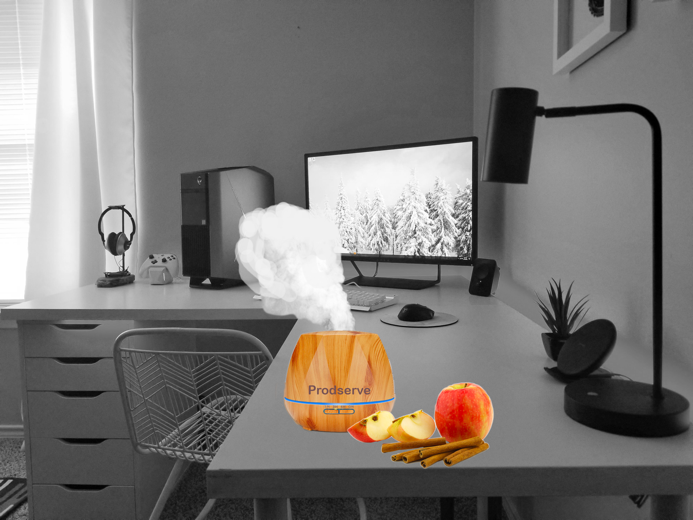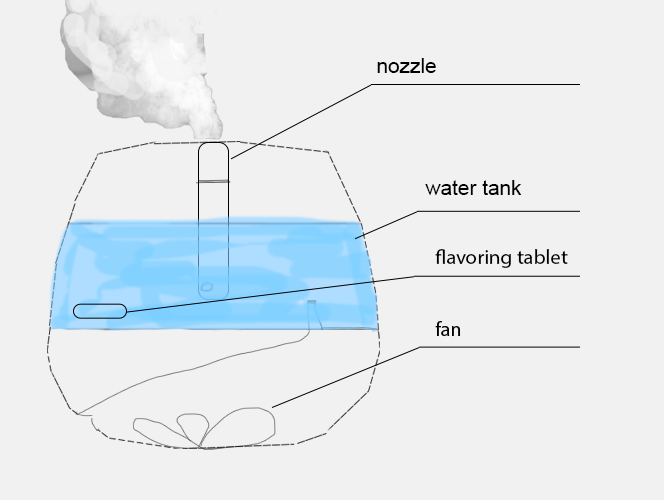Step One: Product Selection
In this step, it was suggested to choose one of the products that fictitious company Prodserve, Corp. will plan to release. Among the proposed options, the choice was stopped on the Humidifier™ with a built-in aromatization function. The device allows cooling the ambient air and increasing humidity, coupled with giving the environment flavors of mint, cinnamon, apples, and spices..
Step Two: Marketing Research
Assignment
The cool air Humidifier™, modified with a refreshing function, is an intelligent electronic device powered by electricity. It is known that humidity is an essential biological indicator that directly affects important body structures such as skin, airways, lips (Moore & Sullivan, 2020). The air Humidifier™ from Prodserve works to eliminate the unwanted effects of dry air in combination with the aromatization of the surrounding space.

Principle of Operation
The principle of operation of the device is entirely based on automatic calculations made inside the Humidifier™ matrix. The device is placed on a hard surface, be it a floor, a desktop, or a cabinet, after which the user sets the spraying mode. Thus, the only variable that is manipulated by the customer is the time after which the Prodserve Humidifier™ re-releases the air. In automatic mode, it periodically releases finely dispersed high-pressure water, saturated with particles of natural flavors, and creates a pleasant, tasty room atmosphere. Airstreams penetrate into the device, where, under the influence of a silent fan, directed to the water tanks. On the way of air masses movement, two membrane filters are installed, designed for ultrasonic cleaning and removal of large drops of water. Purified and moist air enters the nozzle, where under the influence of high pressure is distributed to the room in the form of cold steam.

Design
The home appliance, a cool air Humidifier™, is available on the market in a minimalist design with backlighting that allows seeing the device even at night. A significant advantage of the Humidifier™ is the presence of an air-flavoring function, which can be used at the user’s discretion. In particular, it is up to the customer to decide whether or not to add the flavored tablet to the water tank.
Width and Depth of the Product
Without additional information about the products sold by Prodserve, it is worth assuming that the Humidifier™ is the only product line. However, when purchasing a device, the customer has a choice since the Humidifier™ is available in black, gray, and wood color. In addition, when purchasing a miniature device, the customer can use any of the three scents separately or mix them. Thus, the width of the product is 1, and the depth is 3 (by color) or 4 (by flavor). The Humidifier™ belongs to the category of consumer products, namely, products for convenience and comfort (Lamb, Hair, & McDaniel, 2018).
Branding Strategies
The marketing campaign to promote this product should focus on two main areas: the miniaturization of the device and the benefits to the body. These are the two factors that will cause the buyer’s desire to purchase the product. Advertising promotional videos, posters, and an article will tell potential customers about the importance of maintaining sufficient humidity coupled with the convenience of using a Humidifier™. It is possible that additional medical research may be conducted to promote the device, demonstrating its benefits. Simultaneously, the miniature size of the device allows moving it from room to room, while the built-in mechanism has enough power to refresh the room with clean, moist air in a few minutes.
Prodserve, Corp. should position itself as a company engaged in the development of intelligent devices that make life easier for customers. The company’s marketing department must develop a strategic customer positioning plan that focuses on identifying the target audience and creating promotional materials (Lamb, Hair, & McDaniel, 2018). The preliminary analysis allows estimating that the primary consumers of Humidifiers™ are those categories of population that spend more time at home: housewives, pregnant women, pensioners, and remote workers. The company should create the right first impression of the brand so that in the future, it will be possible to expand the range of products, for instance, smart air conditioners with smoke sensor function, fan-lamp, or heaters modified with the effect of air freshener. Product packaging should reflect the ideas promoted by the company (“Product packaging and branding,” n.d.). In particular, it is suggested that Prodserve, Corp. creates a square carton pack that is 6×6 inches in size. The cardboard should be coated with white, black, or wood paint depending on the color of the device. The box does not provide almost any information about the product except that on the front of the package there is written:
Humidifier
Bring the cinnamon to your home
Thus, the box will stand out from the colored competitors and arouse buyers’ interest in the mystery and ambiguity of the content.
Step Three: Distribution Models
In the marketing environment, there are two models of product distribution from manufacturer to buyer: direct and indirect. The direct way focuses on direct sales between the two sides of the sale, while indirect distribution considers the intermediary side: it can be retail stores, agents, or wholesale bases. In order to simplify the visualization of the comparison of different models, Table 1 was created.
Table 1. Comparative analysis of direct and indirect product distribution models
Based on the research conducted and taking into account the small size of Prodserve, Corp., the right strategy in the initial stages will be positioning on direct distribution channels (Chennamaneni, Desiraju, & Krishnamoorthy, 2017). Determining the demand for the offered goods is of primary importance, so the financial and intellectual costs to deliver the goods to the store shelves may be unjustified. A company must invest the money it saves in advertising campaigns and collaboration with bloggers, public or political figures. Once commercial success has been achieved, a company may begin to develop its product lines by expanding its customer base. For this purpose, retailers such as supermarkets and intellectual goods (e-goods) stores would be an appropriate solution (Mendiola, 2017). However, with updated distribution models, the company should leave the direct sales channel and offer customers a reduced cost when buying online through the website. This step will help retain customers in conjunction with an expanding customer base.
References
Chennamaneni, P. R., Desiraju, R., & Krishnamoorthy, A. (2017). Advance sales of services: Using direct versus indirect channels. Journal of Service Research, 20(2), 135-151.
Lamb, C. W., Hair, J. F., & McDaniel, C. D. (2018). MKTG 12: Principles of marketing paperback. Boston, MA: Cengage Learning.
Mendiola, J. (2017). Direct vs. indirect distribution. Web.
Moore, K. and Sullivan, D. (2020). Humidifiers and health. Web.
Product packaging and branding. (n.d.). Web.
Ross, S. (2019). Direct vs. indirect distribution channel: What’s the difference? Web.